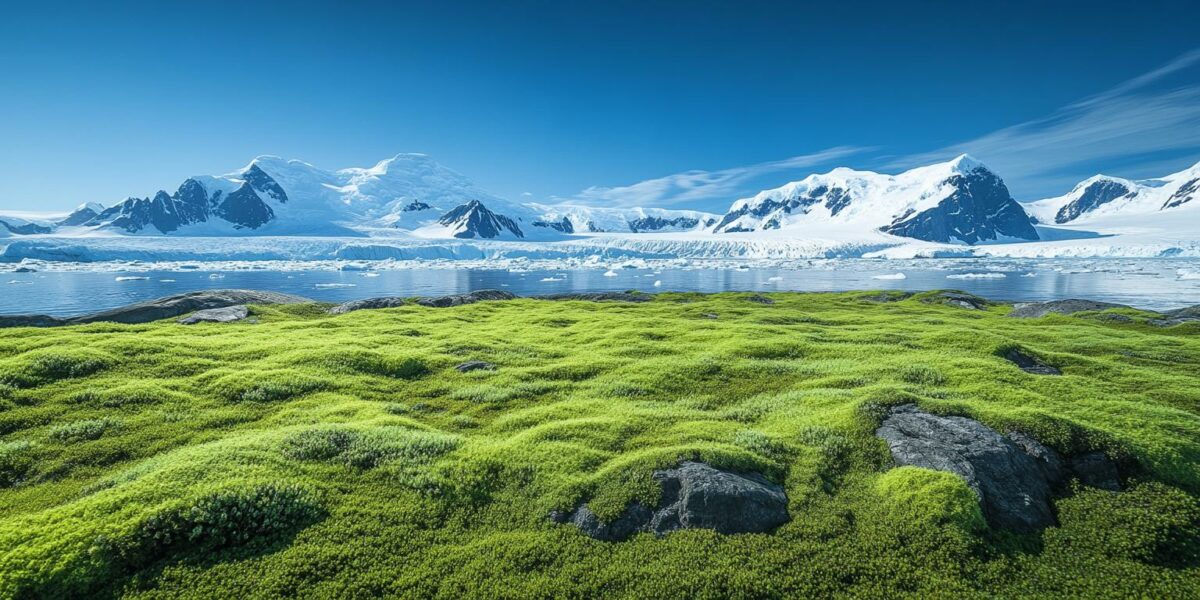Antarctica’s Unprecedented Green Growth
The Antarctic Peninsula is witnessing remarkable vegetation expansion as the climate crisis intensifies. A detailed study has shown an increase from less than one square kilometer of plant cover in 1986 to nearly 12 km² by 2021. This rise, predominantly of mosses, marks a significant transformation in this ice-dominated region.
Researchers have observed a notable acceleration in plant coverage since 2016, highlighting the rapid pace of change. The continent’s warming, which surpasses the global average, reveals the extent of climate change’s impact. This development may pave the way for invasive species to encroach upon Antarctica’s pristine ecosystem.
Similar greening trends are observed in the Arctic, raising concerns about future ecological shifts. The phenomenon is not isolated, as evidenced by unprecedented rain on Greenland’s ice cap in 2021. These events indicate a broader pattern of climate impact on polar regions, reshaping their landscapes and ecosystems.
Dr. Thomas Roland of the University of Exeter emphasizes the significance of these findings. Although snow, ice, and rock still dominate, the increased plant life underscores climate change’s reach into once isolated areas. The Antarctic Peninsula, an area of approximately 500,000 km², is now a crucial indicator of environmental transformation.
Consequences and Concerns
Future warming poses risks of fundamental changes to Antarctica’s biology and landscape. The study, published in Nature Geoscience, relies on Landsat image analysis. This research underscores the urgency of addressing carbon emissions to mitigate further impacts on this vulnerable region.
Prof. Andrew Shepherd highlights the astonishing pace of change at Larsen Inlet. A beach once beneath the Larsen Ice Shelf, now hosts a river with green algae. He notes:
- The rapid colonization of plants in newly exposed areas.
- Antarctica as a climate change barometer.
- Tipping points as life gains foothold.
This transformation suggests a new ecological epoch for the region, as life swiftly adapts to changing conditions. The implications of these shifts could extend beyond Antarctica, influencing global climate patterns and biodiversity.
The spread of mosses since 2016 aligns with reduced sea ice extent. Warmer, open seas create wetter conditions that favor plant growth. Mosses, capable of colonizing bare rock, lay the groundwork for soil formation, potentially allowing diverse plant life to thrive.
Challenges of a Greening Antarctica
Dr. Olly Bartlett of the University of Hertfordshire warns of potential threats from increased plant life. Though Antarctic soil is sparse, more vegetation can lead to organic matter buildup, facilitating soil formation. This evolution raises concerns about non-native species arriving with visitors to the continent.
Previous studies indicated an increase in moss growth, but did not quantify the area affected. Recent research highlights the spread of Antarctica’s native flowering plants on Signy Island, suggesting broader ecological changes.
Moreover, green algae is now visible across melting snow surfaces on the peninsula. The region’s history of tree growth millions of years ago, when atmospheric CO2 was comparable to today’s levels, serves as a stark reminder of potential future scenarios.
Antarctica’s greening is a vivid testament to the profound effects of human-induced climate change. As the continent continues to transform, scientists and policymakers must grapple with the challenges and opportunities these changes present for the global ecosystem.



rileyhorizon
12 km² of plant cover seems tiny compared to 500,000 km² of the peninsula. Are we overreacting to these changes?
Lucy
This is alarming! Are there any measures being taken to protect the native species from invasive plants?
owen
If plants are thriving, could this mean Antarctica might eventually be habitable? 🤔
jackbeacon
Thanks for highlighting this issue. It’s terrifying to think how fast these changes are happening. Can we reverse this trend?
harrison_seraph
Wow, from ice to moss in just a few decades! Guess penguins will soon have to rent lawn mowers 😄
josephmoonshadow
Isn’t it fascinating how Antarctica is becoming a climate change hotspot? What will this mean for its unique wildlife?